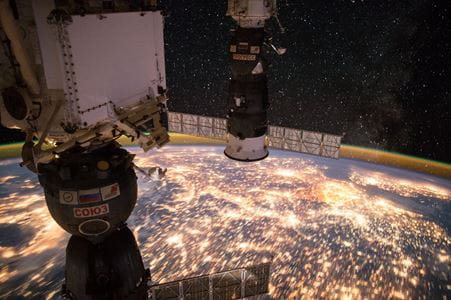NASA astronaut Christina Koch returned to Earth recently after a record-setting 328-day stay on the International Space Station.
The feat is an important milestone for women in the space program and is just 12 days shy of the overall 340-day record set by former astronaut Scott Kelly.
But space exploration doesn’t come without sacrifice. In addition to spending nearly a year away from the people and places she loves, Koch likely suffered adverse side effects due to her time in outer space, including bone and muscle loss, calcium buildups and exposure to radiation.
It also serves as an opportunity for researchers at Indiana University School of Medicine to dig deeper into the effects of prolonged space travel.
Koch’s extended time aboard the International Space Station will give researchers “the opportunity to observe the effects of long-duration spaceflight on a woman,” according to The Associated Press.
Since NASA plans to extend its space flights, return to the moon and explore Mars, understanding these issues—the causes of some which are still unknown—is essential.
Melissa Kacena, PhD, director of basic and translational research and professor in the Department of Orthopaedic Surgery at Indiana University School of Medicine, partners with NASA and the U.S. Army to study bone healing and understand the effect weightlessness has on the skeleton.
Astronauts lose the amount of bone in one month in space that someone with osteoporosis loses in one year on Earth. That’s more than 10-times the bone loss in spaceflight.
Kacena’s research seeks to improve the understanding of the interaction of the bone and hematopoietic systems, thereby improving the treatment of metabolic bone disease, hematopoietic disorders and fracture healing.
Other focuses include: the role of megakaryocytes in regulating osteoblasts proliferation and bone formation; the molecular mechanisms underlying bone repair and fracture healing; osteoblasts and the hematopoietic stem cell niche; as well as the effects of spaceflight on bone regeneration.
NASA knows the physical toll of traveling to outer space and takes precautions to protect its astronauts through medications and exercise, Kacena said. The drugs she’s working to develop will assist with that mission.
Through her partnership with NASA and the U.S. Army, Kacena and her research team has sent two experiments into space.
In 2017, the team sent mice into space, where they were tested using bone-healing therapies in weightlessness through a project dubbed Rodent Research-IV. The goal was to determine how those therapies could be utilized in clinical settings on Earth—and they have the same aspirations this time.
In July, Kacena and eight learners returned to Cape Canaveral, Florida to send osteoblast cells to the International Space Station, where they were cultured for two weeks by astronauts.
Osteoblasts are cells essential to bone development. As their counterparts, osteoclasts, break down bone, osteoblasts work to reform them. The resorption process—which takes about seven years naturally on Earth where gravity is present—is sped up in the weightlessness of space.
IU researchers monitored how spaceflight changed the cells and the effects of an FDA-approved drug as well as a novel drug identified by Kacena on bone healing.
